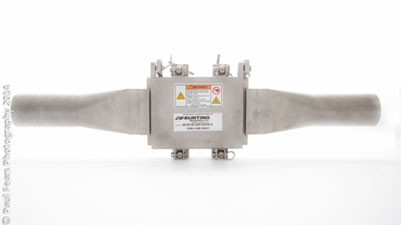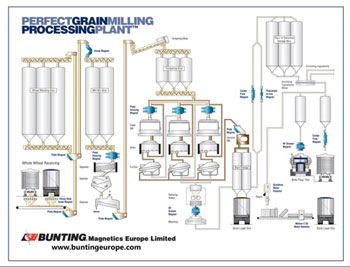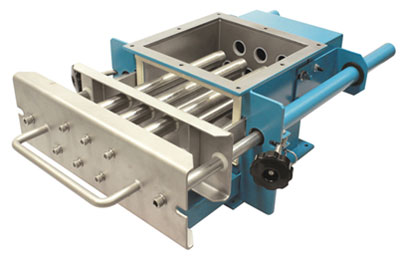Getting metal out of grain and cereals
- Like
- Digg
- Del
- Tumblr
- VKontakte
- Buffer
- Love This
- Odnoklassniki
- Meneame
- Blogger
- Amazon
- Yahoo Mail
- Gmail
- AOL
- Newsvine
- HackerNews
- Evernote
- MySpace
- Mail.ru
- Viadeo
- Line
- Comments
- Yummly
- SMS
- Viber
- Telegram
- Subscribe
- Skype
- Facebook Messenger
- Kakao
- LiveJournal
- Yammer
- Edgar
- Fintel
- Mix
- Instapaper
- Copy Link
Posted: 6 October 2016 | BUNTING Magnetics Europe Ltd | 1 comment
A guide to the ideal location for magnetic separators and metal detectors in a grain and cereal processing plant…


By the time grain and cereals have been collected and delivered to a Milling Plant, it is highly likely that there is metal contamination present. Removing that metal to prevent damage to processing equipment and to produce the highest quality end-product is essential and achieved with a series of different designs of Magnetic Separators and Metal Detectors.


A plant flow sheet illustrating the ideal location for Magnetic Separators and Metal Detectors to remove metal contamination from Grain and Cereals
Metal can be removed at various locations within a plant, as this guide illustrates.
Step 1 – Whole Wheat Receipt
Material being discharged from the back of the transportation can be fed through a heavy duty Grate Magnet, to catch larger tramp ferrous metal. The grain is then conveyed and fed into an elevator, where a Plate Magnet can be positioned on the side of the receiving hopper to capture smaller ferrous metals. Another option is to install a Magnetic Separation Pulley on the end of the conveyor.
Step 2 – After Wheat Blending Silos
A second Plate Magnet can be positioned on the side of the receiving hopper of the second elevator after the wheat has been discharged from the blending silos. This removes any ferrous metal contamination that has been liberated during the blending process.
Another option is to install a Hump Magnet, which comprises of two Plate Magnets offset inside a doglegged housing, as the elevated wheat is discharged from the elevator into the Mill Mix Silos.
Step 3 – After Mill Mix Silos
Before the wheat mix is fed into a series of screens, aspirators and the de-stoner, a Plate Housing Magnet is ideal to remove any potentially damaging ferrous metal. Often a Plate Magnet is also installed after passing through this stage of processing and separation, on the side of the hopper feeding the next elevator.
Step 4 – After the Tempering Silos
After the tempering silos there is a stage of more delicate processing with expensive and delicate processing equipment such as roller mills, sifters and purifiers followed by reducing rollers. It is critical that metal does not enter this stage and due to the importance a series of high strength, deep field, Plate Housing Magnets are commonly installed above the start of the process (ie the Roller Mills).
Step 5 – Fine Material After the Reducing Rollers
At this stage, the material has been significantly reduced in size and different designs of Magnetic Separator are required to remove smaller and weakly magnetic particles. After the reducing rollers, a Drawer Magnet is commonly installed, with banks of high strength Rare Earth Tube Magnets. After the material is bleached and whilst being pneumatically conveyed, In-line Magnets, either of a Center Flow or Pneumatic design, are connected into the pipeline.


Step 6 – Coarser Bran after the Purifier
The purifier will separate the bran fraction which will be fed over a Plate Magnet prior to storage and then despatch.
Step 7 – Prior to Despatch and Packing
After enrichment, the various products are ready for despatch. If the flour is being fed under gravity into a transport vessel, then a Drawer Magnet is commonly used as a last final stage of protection against metal contamination. This removes any metal introduced during the process. If the flour is being pneumatically transported into a transport vessel, then the Centre Flow In-Line Magnet is commonly used.


Grate Magnets or Magnetic Separators to capture ferrous metal contamination from free flowing materials
Where flour is being packed on site, a Quicktron Metal Detector is used to detect and remove both ferrous and non-ferrous metal particles, with a final check of the packed material being undertaken using a Metron Metal Detector.
The sequence of different designs and types of Metal Separator ensures that metal being introduced as any stage of the process (ie with the original feed material and during the process) is identified and removed. Removing metal at various stages reduces the damage to processing equipment and ensures productivity targets are met.
For further information on removing metal from a Grain Process or any food production plant, please contact the Bunting Technical Sales team on:
Phone: +44 (0) 1442 875081
Fax: +44 (0) 1442 875009
Email: [email protected]
Web: http://www.buntingeurope.com








Fascinating to read about how many moving parts (magnets) are in use in the grain and cereal processing industry. Its so important that these processes happen so we can ensure the safety of our consumers. Thank you for sharing your information!